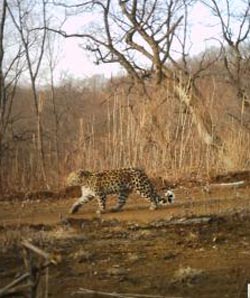First camera trap photos of rare leopard in China

BolyGuard_03.31.2012 06:13:15<br><br>This is the first know camera trap photo of an Amur leopard in China. Credit: Hunchun Amur Tiger National Nature Reserve<br>
The first-known camera trap photos of an Amur leopard in China have recently been taken by protected area staff in Hunchun Amur Tiger National Nature Reserve in Jilin Province according to the Wildlife Conservation Society.
Coupled with Jilin Province's recent announcement of a survey estimating 8-11 leopards across that northern province, the photographs suggest that leopards may be returning to China.
Beginning last month, the Hunchun Reserve's staff set up 16 camera traps in areas where tiger or leopard tracks were found during winter surveys. A dozen of the camera traps were donated by the Wildlife Conservation Society, which has been active for over a decade supporting Russian-Chinese transboundary conservation of Amur tigers and leopards. Several images of Amur tigers were also taken.
Most of the remaining Amur leopards live across the border in Russia, where collaborative camera trapping efforts by WCS, WWF, the Russian Academy of Sciences Institute of Biology and Soils, and the Institute for Sustainable Use of Natural Resources photographed a total of 29 leopards last winter in a portion of the newly created Land of the Leopard National Park. Estimates of the total number of Amur leopards have hovered around 30 since the mid-1970s, but these combined Russian and Chinese results suggest that leopard numbers may be rising to 40 or more.
The Wildlife Conservation Society saves wildlife and wild places worldwide. We do so through science, global conservation, education and the management of the world's largest system of urban wildlife parks, led by the Flagship Bronx Zoo. Together these activities change attitudes toward nature and help people imagine wildlife and humans living in harmony. WCS is committed to this mission because it is essential to the integrity of life on Earth. Visit: http://www.wcs.org
Special Note to the Media: If you would like to guide your readers or viewers to a Web link where they can make donations in support of helping save wildlife and wild places, please direct them to wcs.org.
WCS Digital Community:
Web Sites:
http://www.wcs.org
http://www.bronxzoo.com
http://www.centralparkzoo.com
http://www.queenszoo.com
http://www.prospectparkzoo.com
http://www.nyaquarium.com
Facebook:
Wildlife Conservation Society http://www.facebook.com/TheWCS
Bronx Zoo http://www.facebook.com/bronxzoo
Central Park Zoo http://www.facebook.com/centralparkzoo
Queens Zoo http://www.facebook.com/queenszoo
Prospect Park Zoo http://www.facebook.com/prospectparkzoo
New York Aquarium http://www.facebook.com/nyaquarium
WCS Youtube:
http://www.youtube.com/user/WCSMedia
Twitter:
@TheBronxZoo
@NewYorkAquarium
@TheWCS
Media Contact
More Information:
http://www.wcs.orgAll latest news from the category: Ecology, The Environment and Conservation
This complex theme deals primarily with interactions between organisms and the environmental factors that impact them, but to a greater extent between individual inanimate environmental factors.
innovations-report offers informative reports and articles on topics such as climate protection, landscape conservation, ecological systems, wildlife and nature parks and ecosystem efficiency and balance.
Newest articles

High-energy-density aqueous battery based on halogen multi-electron transfer
Traditional non-aqueous lithium-ion batteries have a high energy density, but their safety is compromised due to the flammable organic electrolytes they utilize. Aqueous batteries use water as the solvent for…

First-ever combined heart pump and pig kidney transplant
…gives new hope to patient with terminal illness. Surgeons at NYU Langone Health performed the first-ever combined mechanical heart pump and gene-edited pig kidney transplant surgery in a 54-year-old woman…

Biophysics: Testing how well biomarkers work
LMU researchers have developed a method to determine how reliably target proteins can be labeled using super-resolution fluorescence microscopy. Modern microscopy techniques make it possible to examine the inner workings…





















